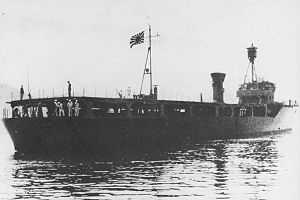Japanese target ship Hakachi
 Hakachi on 9 November 1943 at Aioi | |
| Career (Japan) | |
|---|---|
| Name: | Hakachi |
| Namesake: | Cape of Hakachi |
| Ordered: | fiscal 1941 under the Maru Tsui Programme (Ship number 660) |
| Builder: | Harima Zōsen Corporation, Aioi |
| Cost: | 4.8 millions JPY in 1941 |
| Laid down: | 1 February 1943 |
| Launched: | 27 June 1943 |
| Commissioned: | 18 November 1943 |
| Decommissioned: | 30 November 1945 |
| Fate: | Used as a repatriation transport, later scrapped. |
| General characteristics | |
| Type: | Target ship |
| Displacement: | 1,641 long tons (1,667 t) standard |
| Length: | 93.50 m (306.8 ft) o/a 87.45 m (286.9 ft) pp |
| Beam: | 11.30 m (37 ft 1 in) |
| Draught: | 3.81 m (12 ft 6 in) |
| Propulsion: | 2 × Ho-Gō Kampon water-tube boilers 2 × Kampon geared turbines, 2 shafts, 4,400 hp (3,300 kW) |
| Speed: | 19.3 knots (22.2 mph; 35.7 km/h) |
| Range: | 4,000 nmi (7,400 km) at 14 knots |
| Complement: | 148 |
| Armament: | 4 × Type 93 13 mm AA guns |
The Hakachi (波勝) was a bomb target ship of the Imperial Japanese Navy (IJN) serving during the Second World War, the only ship of her class.
Background
Project number J32. Before the pacific war, the IJN wanted to raise the training efficiency of bombers for the outbreak of war. The Yakaze was converted to a target ship for bombing training, however, her armour was thin because she was converted from a destroyer. Yakaze was able to bear only 1 kilogram bomb. The IJN wanted the target ship which Combined Fleet could use in the southern front. Hakachi was built by such a background, she was able to bear 10 kilogram bomb dropped from 4,000 m (13,000 ft) meters sky. The IJN built Ōhama-class as a next generation target ships, because Hakachi was only one.
Service
The Hakachi was commissioned on 18 November 1943, on 1 December, she was assigned to the Combined Fleet. On 24 December, she sailed to Truk and she worked bombing training. Two months later, she was heavily damaged by U.S. carrier aircraft during Operation Hailstone. She sheltered to Palau on 24 February 1944, and repaired by Akashi. On 18 March, she sailed to Lingga Islands. On 24 May, she sailed to Davao Gulf. She worked in each place. On 1 October, she undertook convoy escort operation. She Survived war at the Seto Inland Sea.
Bibliography
- Ships of the World special issue Vol.47 Auxiliary Vessels of the Imperial Japanese Navy, Kaijinsha, (Japan), March 1997
- The Maru Special, Japanese Naval Vessels No.34, Japanese Auxiliary ships, Ushio Shobō (Japan), December 1979
- Senshi Sōsho Vol.31, Naval armaments and war preparation (1), "Until November 1941", Asagumo Simbun (Japan), November 1969
| ||||||||||||||||||||||||||||||||||||||||||||||||||||||||||||||||||